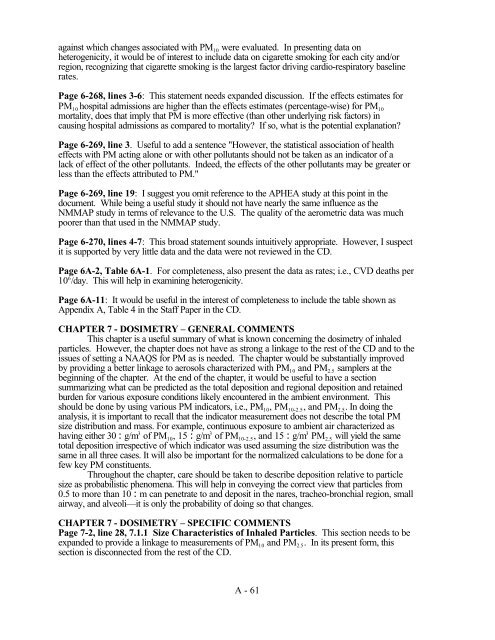Review of the Air Quality Criteria Document for Particulate Matter
Review of the Air Quality Criteria Document for Particulate Matter
Review of the Air Quality Criteria Document for Particulate Matter
- No tags were found...
You also want an ePaper? Increase the reach of your titles
YUMPU automatically turns print PDFs into web optimized ePapers that Google loves.
against which changes associated with PM 10 were evaluated. In presenting data onheterogenicity, it would be <strong>of</strong> interest to include data on cigarette smoking <strong>for</strong> each city and/orregion, recognizing that cigarette smoking is <strong>the</strong> largest factor driving cardio-respiratory baselinerates.Page 6-268, lines 3-6: This statement needs expanded discussion. If <strong>the</strong> effects estimates <strong>for</strong>PM 10 hospital admissions are higher than <strong>the</strong> effects estimates (percentage-wise) <strong>for</strong> PM 10mortality, does that imply that PM is more effective (than o<strong>the</strong>r underlying risk factors) incausing hospital admissions as compared to mortality? If so, what is <strong>the</strong> potential explanation?Page 6-269, line 3. Useful to add a sentence "However, <strong>the</strong> statistical association <strong>of</strong> heal<strong>the</strong>ffects with PM acting alone or with o<strong>the</strong>r pollutants should not be taken as an indicator <strong>of</strong> alack <strong>of</strong> effect <strong>of</strong> <strong>the</strong> o<strong>the</strong>r pollutants. Indeed, <strong>the</strong> effects <strong>of</strong> <strong>the</strong> o<strong>the</strong>r pollutants may be greater orless than <strong>the</strong> effects attributed to PM."Page 6-269, line 19: I suggest you omit reference to <strong>the</strong> APHEA study at this point in <strong>the</strong>document. While being a useful study it should not have nearly <strong>the</strong> same influence as <strong>the</strong>NMMAP study in terms <strong>of</strong> relevance to <strong>the</strong> U.S. The quality <strong>of</strong> <strong>the</strong> aerometric data was muchpoorer than that used in <strong>the</strong> NMMAP study.Page 6-270, lines 4-7: This broad statement sounds intuitively appropriate. However, I suspectit is supported by very little data and <strong>the</strong> data were not reviewed in <strong>the</strong> CD.Page 6A-2, Table 6A-1. For completeness, also present <strong>the</strong> data as rates; i.e., CVD deaths per10 6 /day. This will help in examining heterogenicity.Page 6A-11: It would be useful in <strong>the</strong> interest <strong>of</strong> completeness to include <strong>the</strong> table shown asAppendix A, Table 4 in <strong>the</strong> Staff Paper in <strong>the</strong> CD.CHAPTER 7 - DOSIMETRY – GENERAL COMMENTSThis chapter is a useful summary <strong>of</strong> what is known concerning <strong>the</strong> dosimetry <strong>of</strong> inhaledparticles. However, <strong>the</strong> chapter does not have as strong a linkage to <strong>the</strong> rest <strong>of</strong> <strong>the</strong> CD and to <strong>the</strong>issues <strong>of</strong> setting a NAAQS <strong>for</strong> PM as is needed. The chapter would be substantially improvedby providing a better linkage to aerosols characterized with PM 10 and PM 2.5 samplers at <strong>the</strong>beginning <strong>of</strong> <strong>the</strong> chapter. At <strong>the</strong> end <strong>of</strong> <strong>the</strong> chapter, it would be useful to have a sectionsummarizing what can be predicted as <strong>the</strong> total deposition and regional deposition and retainedburden <strong>for</strong> various exposure conditions likely encountered in <strong>the</strong> ambient environment. Thisshould be done by using various PM indicators, i.e., PM 10 , PM 10-2.5 , and PM 2.5 . In doing <strong>the</strong>analysis, it is important to recall that <strong>the</strong> indicator measurement does not describe <strong>the</strong> total PMsize distribution and mass. For example, continuous exposure to ambient air characterized ashaving ei<strong>the</strong>r 30 :g/m 3 <strong>of</strong> PM 10 , 15 :g/m 3 <strong>of</strong> PM 10-2.5 , and 15 :g/m 3 PM 2.5 will yield <strong>the</strong> sametotal deposition irrespective <strong>of</strong> which indicator was used assuming <strong>the</strong> size distribution was <strong>the</strong>same in all three cases. It will also be important <strong>for</strong> <strong>the</strong> normalized calculations to be done <strong>for</strong> afew key PM constituents.Throughout <strong>the</strong> chapter, care should be taken to describe deposition relative to particlesize as probabilistic phenomena. This will help in conveying <strong>the</strong> correct view that particles from0.5 to more than 10 :m can penetrate to and deposit in <strong>the</strong> nares, tracheo-bronchial region, smallairway, and alveoli—it is only <strong>the</strong> probability <strong>of</strong> doing so that changes.CHAPTER 7 - DOSIMETRY – SPECIFIC COMMENTSPage 7-2, line 28, 7.1.1 Size Characteristics <strong>of</strong> Inhaled Particles. This section needs to beexpanded to provide a linkage to measurements <strong>of</strong> PM 10 and PM 2.5 . In its present <strong>for</strong>m, thissection is disconnected from <strong>the</strong> rest <strong>of</strong> <strong>the</strong> CD.A - 61
















